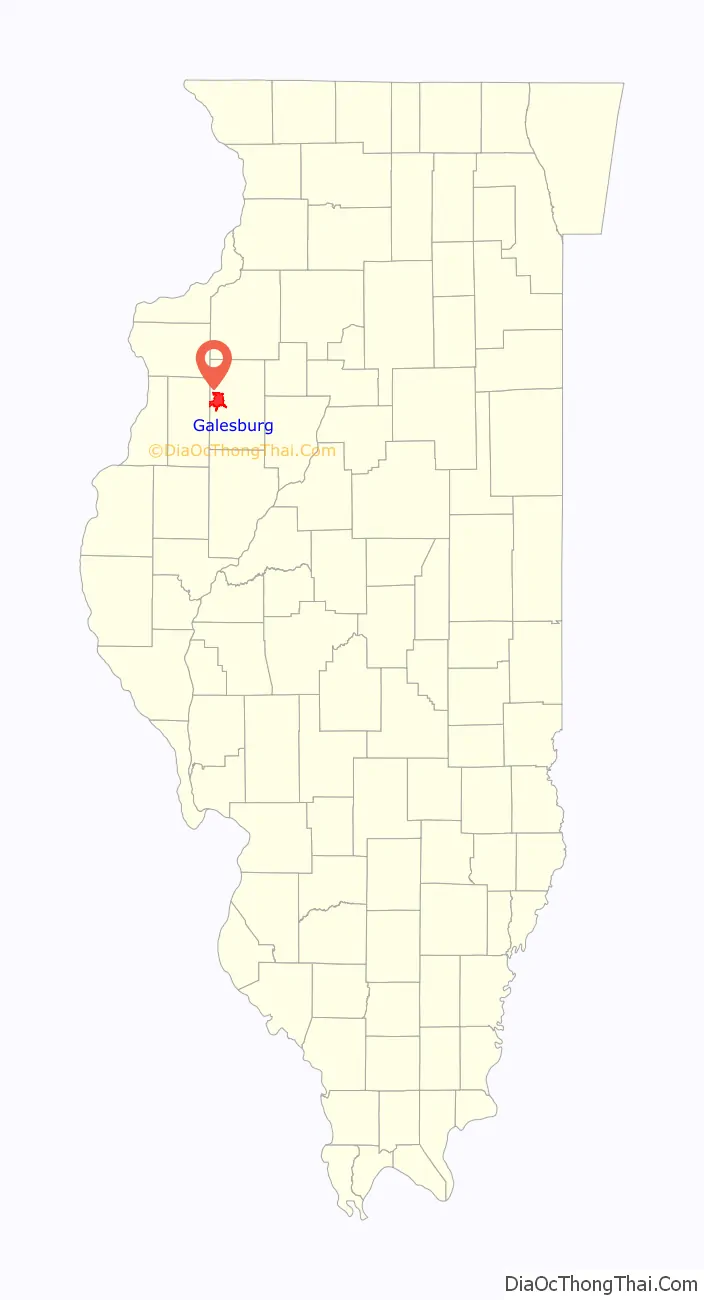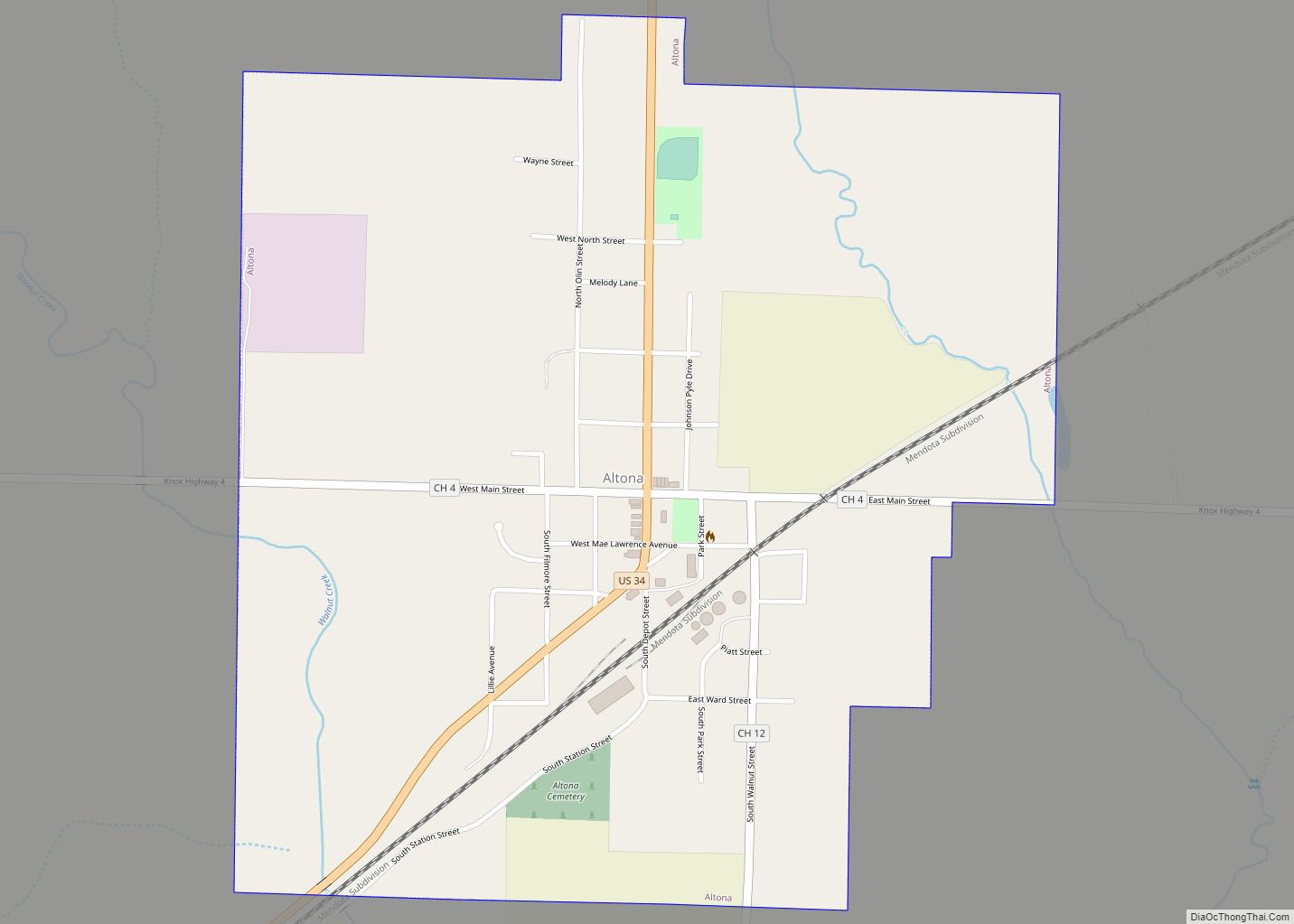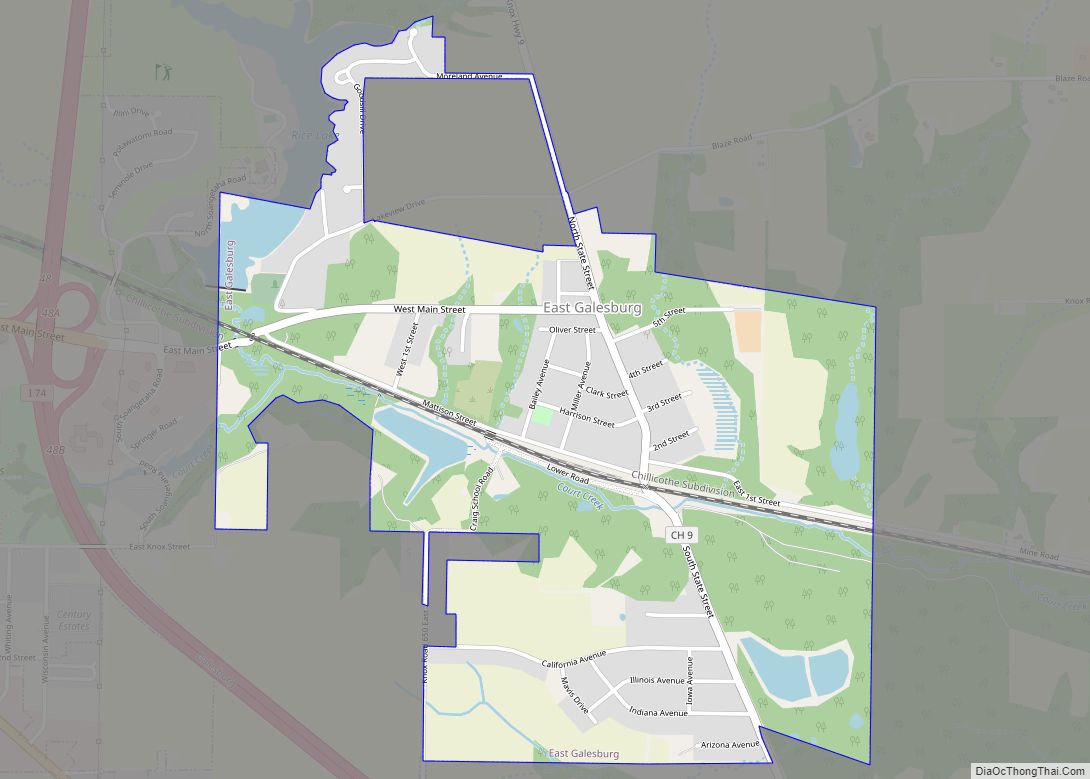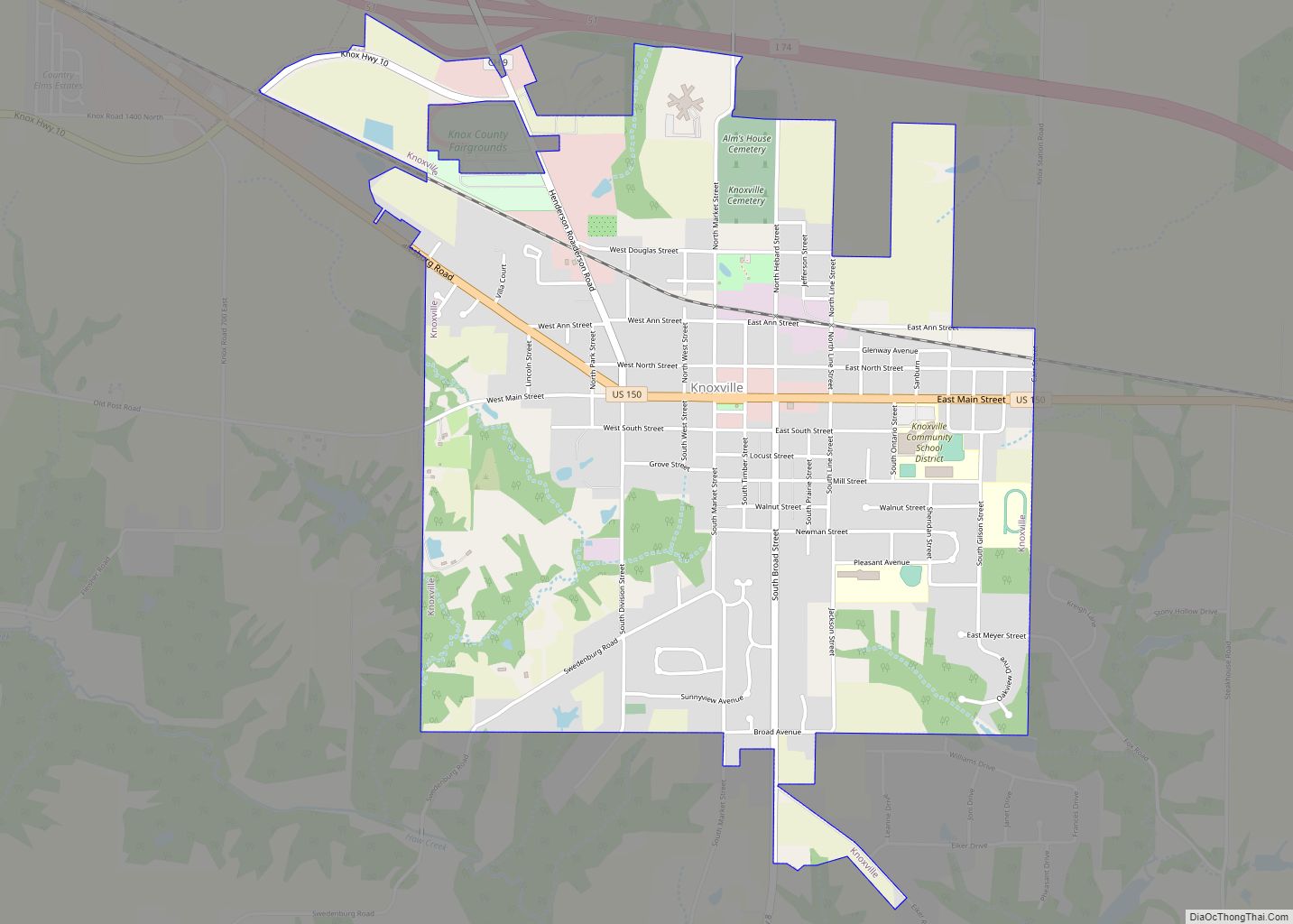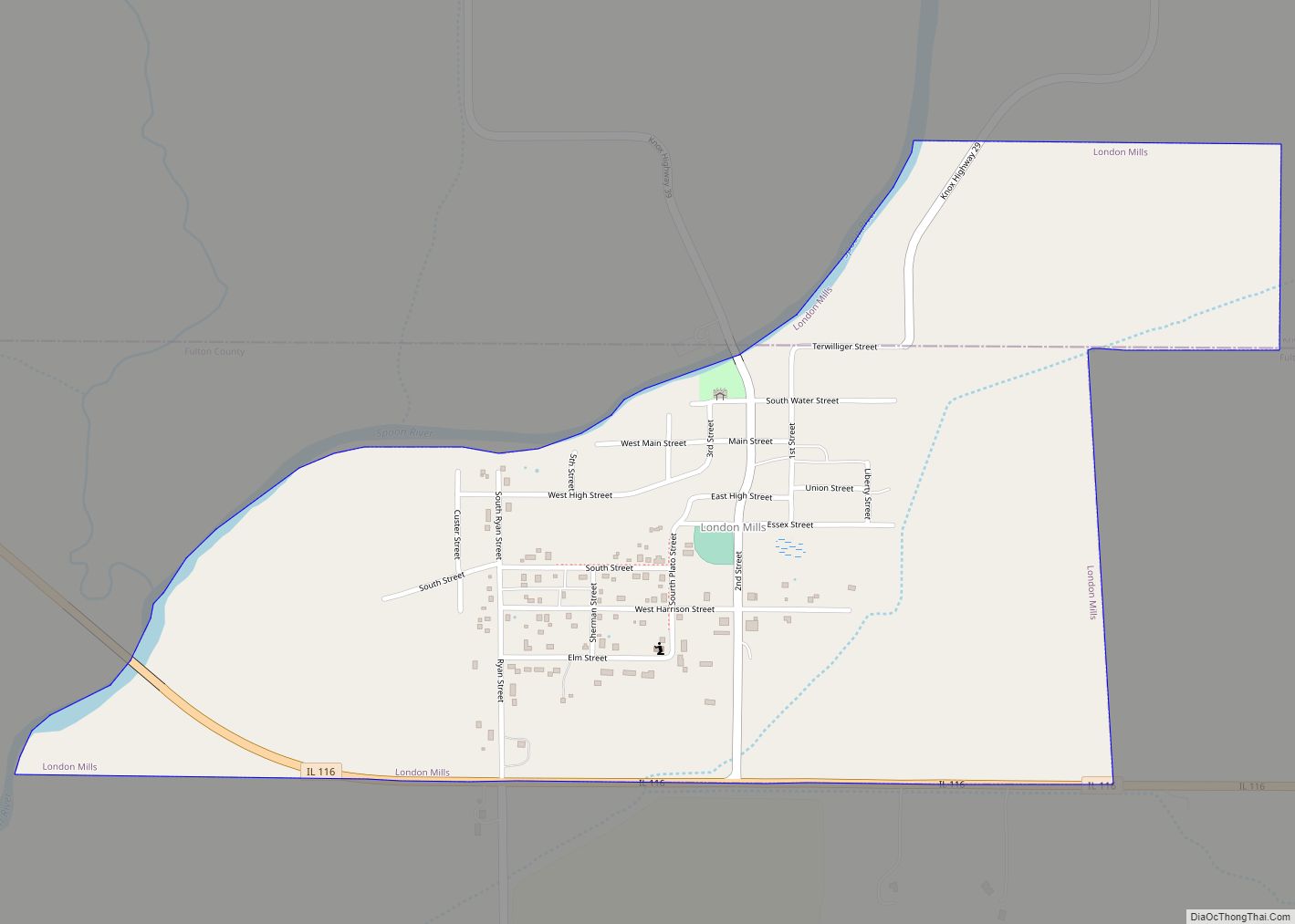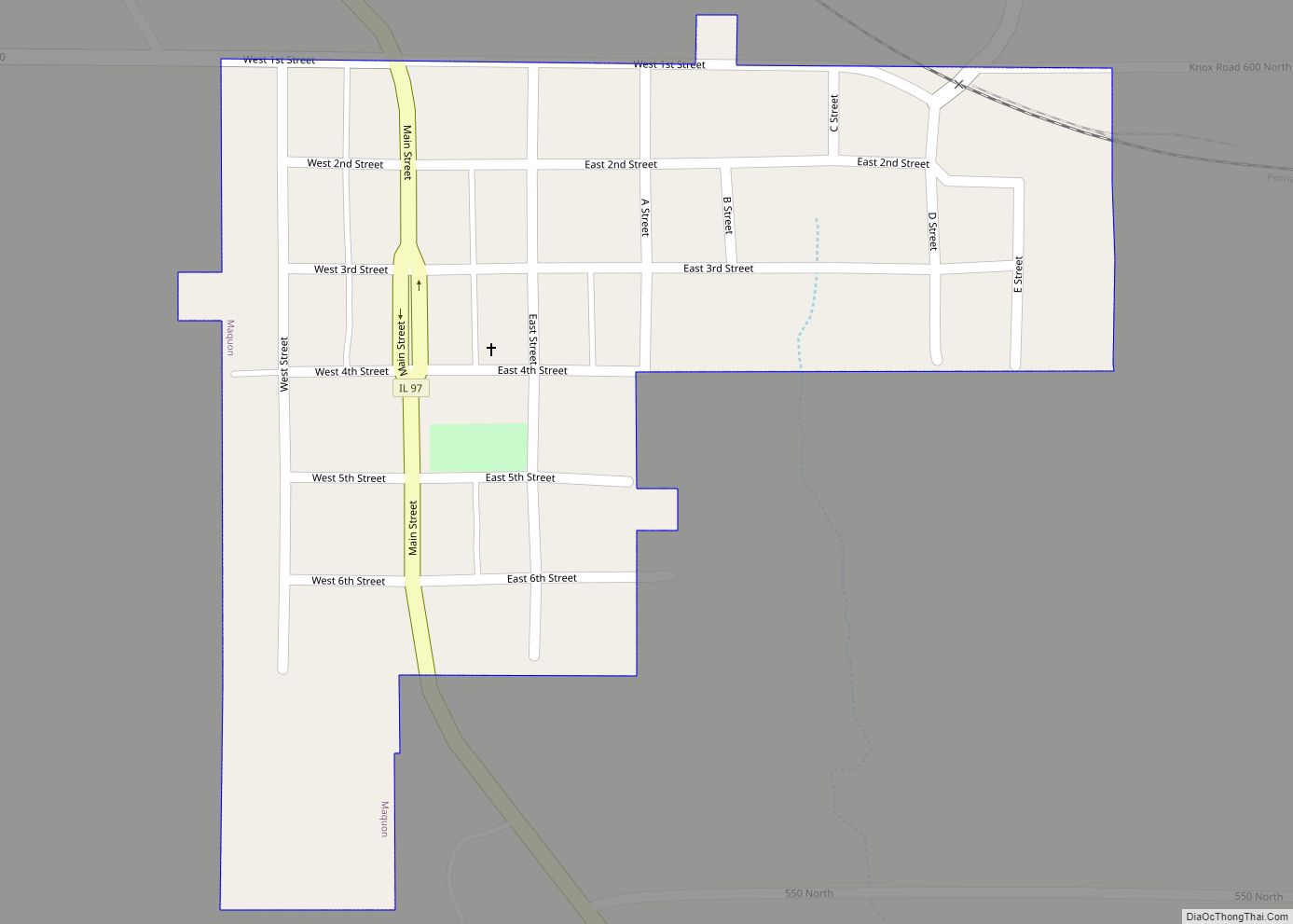Galesburg is a city in Knox County, Illinois, United States. The city is 45 miles (72 km) northwest of Peoria. At the 2010 census, its population was 32,195. It is the county seat of Knox County and the principal city of the Galesburg Micropolitan Statistical Area, which includes all of Knox and Warren counties.
Galesburg is home to Knox College, a private four-year liberal arts college, and Carl Sandburg College, a two-year community college.
A 496-acre (201 ha) section of the city is listed on the National Register of Historic Places as the Galesburg Historic District.
| Name: | Galesburg city |
|---|---|
| LSAD Code: | 25 |
| LSAD Description: | city (suffix) |
| State: | Illinois |
| County: | Knox County |
| Founded: | 1837 |
| Elevation: | 771 ft (235 m) |
| Total Area: | 17.94 sq mi (46.45 km²) |
| Land Area: | 17.76 sq mi (45.99 km²) |
| Water Area: | 0.18 sq mi (0.46 km²) |
| Total Population: | 30,052 |
| Population Density: | 1,692.21/sq mi (653.38/km²) |
| ZIP code: | 61401 |
| Area code: | 309 |
| FIPS code: | 1728326 |
| GNISfeature ID: | 2394842 |
| Website: | www.ci.galesburg.il.us |
Online Interactive Map
Click on ![]() to view map in "full screen" mode.
to view map in "full screen" mode.
Galesburg location map. Where is Galesburg city?
History
Galesburg was founded by George Washington Gale, a Presbyterian minister from New York state who had formulated the concept of the manual labor college and first implemented it at the Oneida Institute near Utica, New York. In 1836 Gale publicized a subscription- and land purchase-based plan to found manual labor colleges in the Mississippi River valley. Land was purchased for this purpose in Knox County and in 1837 the first subscribers to the college-founding plan arrived and began to settle what would become Galesburg.
Galesburg, populated from the first by abolitionists, was home to one of the first anti-slavery societies in Illinois and was a stop on the Underground Railroad. The city was the site of the fifth Lincoln–Douglas debate. held on October 7, 1858. Galesburg also was the home of Mary Ann “Mother” Bickerdyke, who provided hospital care for Union soldiers during the Civil War.
In later years, Galesburg became the birthplace of poet Carl Sandburg, artist Dorothea Tanning, and former Major League Baseball star Jim Sundberg. Sandburg’s boyhood home is maintained by the Illinois Historic Preservation Agency as the Carl Sandburg State Historic Site. It includes the cottage he was born in, a modern museum, the rock under which he and his wife Lilian are buried, and a performance venue.
Throughout much of its history, Galesburg has been inextricably tied to the railroad industry. Local businessmen were major backers of the first railroad to connect Illinois’s then two biggest cities—Chicago and Quincy—as well as a third leg initially terminating across the Mississippi River from Burlington, Iowa, eventually connecting to it via bridge and thence onward to the Western frontier. The Chicago, Burlington and Quincy Railroad (CB&Q) sited major rail sorting yards here, including the first to use hump sorting. The CB&Q also built a major depot on South Seminary Street that was controversially torn down and replaced by a much smaller station in 1983. The yard is still used by the BNSF Railway.
In the late 19th century, when the Atchison, Topeka and Santa Fe Railway connected its service through to Chicago, it also laid track through Galesburg and built its own railroad depot. The depot remained in operation until the construction of the Cameron Connector southwest of town enabled Amtrak to reroute the Southwest Chief via the Mendota Subdivision and join the California Zephyr and Illinois Zephyr at the Burlington Northern depot. A series of mergers eventually united both lines under the ownership of BNSF Railway, carrying an average of seven freight trains per hour between them. With the closure of the Maytag plant in 2004, BNSF is once again the largest private employer in Galesburg.
Galesburg was home to the pioneering brass era automobile company Western, which produced the Gale, named for the town.
Galesburg was home to minor league baseball from 1890 to 1914. The Galesburg Pavers was the last name of the minor league teams based in Galesburg. Galesburg teams played as members of the Eastern Iowa League (1895), Central Interstate League (1890), Illinois-Iowa League (1890), Illinois-Missouri League (1908–1909) and Central Association (1910–1912, 1914).
Baseball Hall of Fame members Grover Cleveland Alexander (1909) and Sam Rice (1912) played for Galesburg. Rice had to leave the Galseburg team in 1912, when his wife, two children, his parents and two sisters were killed in a tornado. Galesburg teams played at Illinois Field (1908–1912, 1914), Lombard College Field (1908–1912, 1914) and Willard Field at Knox College (1890, 1895).
Lombard College was in Galesburg until 1930, and is now the site of Lombard Middle School.
The Carr Mansion at 560 North Prairie Street was the site of a presidential cabinet meeting held in 1899 by U.S. President William McKinley and U.S. Secretary of State John Hay.
Galesburg Road Map
Galesburg city Satellite Map
Geography
Galesburg is in western Knox County. Interstate 74 runs through the east side of the city, leading southeast 47 miles (76 km) to Peoria and north 36 miles (58 km) to Interstate 80 near the Quad Cities area.
According to the 2010 census, Galesburg has a total area of 17.928 square miles (46.43 km), of which 17.75 square miles (45.97 km) (or 99.01%) are land and 0.178 square miles (0.46 km) (or 0.99%) are water.
Climate
See also
Map of Illinois State and its subdivision:- Adams
- Alexander
- Bond
- Boone
- Brown
- Bureau
- Calhoun
- Carroll
- Cass
- Champaign
- Christian
- Clark
- Clay
- Clinton
- Coles
- Cook
- Crawford
- Cumberland
- De Kalb
- De Witt
- Douglas
- Dupage
- Edgar
- Edwards
- Effingham
- Fayette
- Ford
- Franklin
- Fulton
- Gallatin
- Greene
- Grundy
- Hamilton
- Hancock
- Hardin
- Henderson
- Henry
- Iroquois
- Jackson
- Jasper
- Jefferson
- Jersey
- Jo Daviess
- Johnson
- Kane
- Kankakee
- Kendall
- Knox
- La Salle
- Lake
- Lake Michigan
- Lawrence
- Lee
- Livingston
- Logan
- Macon
- Macoupin
- Madison
- Marion
- Marshall
- Mason
- Massac
- McDonough
- McHenry
- McLean
- Menard
- Mercer
- Monroe
- Montgomery
- Morgan
- Moultrie
- Ogle
- Peoria
- Perry
- Piatt
- Pike
- Pope
- Pulaski
- Putnam
- Randolph
- Richland
- Rock Island
- Saint Clair
- Saline
- Sangamon
- Schuyler
- Scott
- Shelby
- Stark
- Stephenson
- Tazewell
- Union
- Vermilion
- Wabash
- Warren
- Washington
- Wayne
- White
- Whiteside
- Will
- Williamson
- Winnebago
- Woodford
- Alabama
- Alaska
- Arizona
- Arkansas
- California
- Colorado
- Connecticut
- Delaware
- District of Columbia
- Florida
- Georgia
- Hawaii
- Idaho
- Illinois
- Indiana
- Iowa
- Kansas
- Kentucky
- Louisiana
- Maine
- Maryland
- Massachusetts
- Michigan
- Minnesota
- Mississippi
- Missouri
- Montana
- Nebraska
- Nevada
- New Hampshire
- New Jersey
- New Mexico
- New York
- North Carolina
- North Dakota
- Ohio
- Oklahoma
- Oregon
- Pennsylvania
- Rhode Island
- South Carolina
- South Dakota
- Tennessee
- Texas
- Utah
- Vermont
- Virginia
- Washington
- West Virginia
- Wisconsin
- Wyoming

